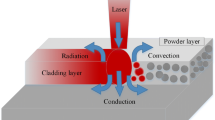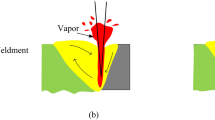Abstract
Laser direct energy deposition (L-DED) can improve the forming efficiency of parts by controlling laser power, scanning speed, powder flow rate, and spot size. It is a good way to complete the processing and repair of complex parts. In this paper, a three-dimensional numerical model is established to study the dynamic cladding process (pool geometry, energy transfer, and dynamic solidification) of Inconel718 alloy during direct energy deposition. The fluid of volume (VOF) method is used to track the free surface of the melt pool, and the powder source model is established by discrete method. The results show that the molten pool size (area, width, height, depth) of the model is relatively uniform and can predict the shape of the molten pool well. The energy transfer in the molten pool is disturbed to some extent by the metal powder flow. The temperature gradient and cooling rate of the cladding layer are relatively large near the mushy area during the solidification process.












Similar content being viewed by others
Data availability
All data generated or analyzed during this study are included in this published article.
References
Aggarwal A, Patel S, Kumar A (2018) Selective laser melting of 316L stainless steel: physics of melting mode transition and its influence on microstructural and mechanical behavior. JOM 71(3):1105–1116. https://doi.org/10.1007/s11837-018-3271-8
Khairallah SA, Anderson AT, Rubenchik A, King WE (2016) Laser powder-bed fusion additive manufacturing: physics of complex melt flow and formation mechanisms of pores, spatter, and denudation zones. Acta Mater 108:36–45. https://doi.org/10.1016/j.actamat.2016.02.014
Ferro P, Berto F, Romanin L (2020) Understanding powder bed fusion additive manufacturing phenomena via numerical simulation. Frattura ed Integrità Strutturale 14(53):252–284. https://doi.org/10.3221/IGF-ESIS.53.21
Sreekanth S, Ghassemali E, Hurtig K, Joshi S, Andersson J (2020) Effect of direct energy deposition process parameters on single-track deposits of alloy 718. Metals - Open Access Metallurgy Journal 10(1):96. https://doi.org/10.3390/met10010096
Jhang SS, Lo YL, Le TN (2019) Systematic modeling approach for analyzing the powder flow and powder energy absorptivity in direct energy deposition system. Int J Adv Manuf Technol 105(1–4):1765–1776. https://doi.org/10.1007/s00170-019-04441-3
Hooper PA (2018) Melt pool temperature and cooling rates in laser powder bed fusion. Addit Manuf 22:548–559. https://doi.org/10.1016/j.addma.2018.05.032
Cang, ZhangKamel (2017) Real-time monitoring of laser powder bed fusion process using high-speed X-ray imaging and diffraction. Sci Rep 7(1):1–11. https://doi.org/10.1038/s41598-017-03761-2
Pinkerton AJ (2014) Advances in the modeling of laser direct metal deposition. J Laser Appl 27(S1):S15001. https://doi.org/10.2351/1.4815992
Kong F, Kovacevic R (2010) Modeling of heat transfer and fluid flow in the laser multilayered cladding process. Metall Mater Trans B 41(6):1310–1320. https://doi.org/10.1007/s11663-010-9412-2
Qi H, Mazumder J, Ki H (2006) Numerical simulation of heat transfer and fluid flow in coaxial laser cladding process for direct metal deposition. J Appl Phys 100(2):024903–024903–11. https://doi.org/10.1063/1.2209807
Li C, Yu Z, Gao J, Zhao J, Han X (2018) Numerical simulation and experimental study of cladding Fe60 on an ASTM 1045 substrate by laser cladding. Surf Coat Tech 357:965–977. https://doi.org/10.1016/j.surfcoat.2018.10.099
Jsa B, Gang Y, Xha B, Sla B, Cab B, Zab Y (2019) Grain size evolution under different cooling rate in laser additive manufacturing of superalloy - ScienceDirect. Opt Laser Technol 2019:105662–105662. https://doi.org/10.1016/j.optlastec.2019.105662
Sun Z, Guo W, Li L (2020) Numerical modelling of heat transfer, mass transport and microstructure formation in a high deposition rate laser directed energy deposition process. Addit Manuf 33(10):1–17. https://doi.org/10.1016/j.addma.2020.101175
Bayat M, Mohanty S, Hattel JH (2019) Multiphysics modelling of lack-of-fusion voids formation and evolution in IN718 made by multi-track/multi-layer L-PBF. Int J Heat Mass Tran 139:95–114. https://doi.org/10.1016/j.ijheatmasstransfer.2019.05.003
Ge W, Han S, Na SJ, Fuh JYH (2021) Numerical modelling of surface morphology in selective laser melting. Comput Mater Sci 186:1–8. https://doi.org/10.1016/j.commatsci.2020.110062
Yasa EU, Kruth J (2011) Microstructural investigation of selective laser melting 316L stainless steel parts exposed to laser re-melting. Procedia Eng 19(1):389–395. https://doi.org/10.1016/j.proeng.2011.11.130
Shi Q, Gu D, Xia M, Cao S, Rong T (2016) Effects of laser processing parameters on thermal behavior and melting/solidification mechanism during selective laser melting of TiC/Inconel 718 composites. Opt Laser Technol 84:9–22. https://doi.org/10.1016/j.optlastec.2016.04.009
Dai D, Gu D (2016) Influence of thermodynamics within molten pool on migration and distribution state of reinforcement during selective laser melting of AlN/AlSi10Mg composites. Int J Mach Tools Manuf 100:14–24. https://doi.org/10.1016/j.ijmachtools.2015.10.004
Wang X, Liu PW, Ji Y (2019) Investigation on microsegregation of IN718 alloy during additive manufacturing via integrated phase-field and finite-element modeling. J Mater Eng Perform 28:657–665. https://doi.org/10.1007/s11665-018-3620-3
Heilemann M, Mller M, Emmelmann C (2017) Laser metal deposition of Ti-6Al-4V structures: new building strategy for a decreased shape deviation and its influence on the microstructure and mechanical properties// Lasers in Manufacturing Conference 2017
Dai D, Gu D, Zhang H, Xiong J, Ma C, Hong C, poprawe R (2018) Influence of scan strategy and molten pool configuration on microstructures and tensile properties of selective laser melting additive manufactured aluminum based parts. Opt Laser Technol S0030399217307004.https://doi.org/10.1016/j.optlastec.2017.08.015
Zhao YH, Wang ZG, Long Y, Zhao JB, Lai YB (2015) Research on in fluential factor of temperature of molten pool of inconel 625 superalloy by laser additive manufacturing. Appl Laser Technol 35(002):137–144. https://doi.org/10.3788/AL20153502.0137
Jsa B, Gang Y, Xha B. Grain size evolution under different cooling rate in laser additive manufacturing of superalloy - ScienceDirect. Opt Laser Technol 119:105662–105662. https://doi.org/10.1016/j.optlastec.2019.105662
Nie J, Chen C, Liu L, Wang X, Zhao R, Shuai S, Wang J, Ren Z (2020) Effect of substrate cooling on the epitaxial growth of Ni-based single-crystal superalloy fabricated by direct energy deposition. J Mater Sci Technol 62:148–161. https://doi.org/10.1016/j.jmst.2020.05.041
Sreekanth S, Ghassemali E, Hurtig K, Joshi S, Andersson J (2020) Effect of direct energy deposition process parameters on single-track deposits of alloy 718. metals - Open Access Metallurg J 10(1):96. https://doi.org/10.3390/met10010096
Trivedi R, David SA, Eshelman MA, Vitek JM, Babu SS, Hong T, DebRoy T (2003) In situ observations of weld pool solidification using transparent metal-analog systems. J Appl Phys 93(8):4885–4895. https://doi.org/10.1063/1.1559934
Funding
This study was supported in part by grants from National Natural Science Foundation of China (grant no. 51375082 and U1908230).
Author information
Authors and Affiliations
Contributions
Kaikai Xu established the numerical model and analyzed the results, Yadong Gong guided the content of the paper, and Qiang Zhang checked the grammar of the manuscript.
Corresponding author
Ethics declarations
Ethical approval
Not applicable.
Consent to participate
Not applicable.
Consent for publication
Not applicable.
Competing interests
The authors declare no competing interests.
Additional information
Publisher's Note
Springer Nature remains neutral with regard to jurisdictional claims in published maps and institutional affiliations.
Rights and permissions
Springer Nature or its licensor (e.g. a society or other partner) holds exclusive rights to this article under a publishing agreement with the author(s) or other rightsholder(s); author self-archiving of the accepted manuscript version of this article is solely governed by the terms of such publishing agreement and applicable law.
About this article
Cite this article
Kaikai, X., Yadong, G. & Qiang, Z. Numerical simulation of dynamic analysis of molten pool in the process of direct energy deposition. Int J Adv Manuf Technol 124, 2451–2461 (2023). https://doi.org/10.1007/s00170-022-10271-7
Received:
Accepted:
Published:
Issue Date:
DOI: https://doi.org/10.1007/s00170-022-10271-7




